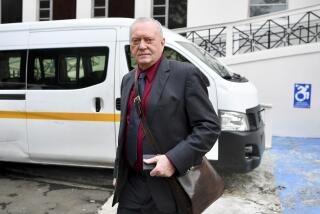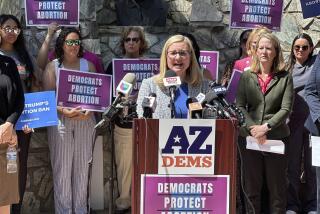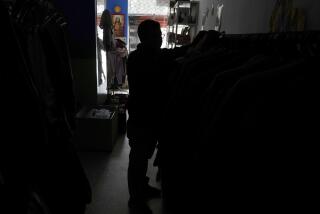Gov. Jerry Brown offers part of a historic budget bonanza to help ease California’s homelessness crisis

Even in the wake of previous tax windfalls, Gov. Jerry Brown’s announcement on Friday was breathtaking: The state has collected an unexpected $8 billion in tax revenue in recent months, even more additional cash than reported in January.
The money is the latest installment in a fiscal winning streak of historic proportions in California. And, as in previous years, the governor’s newly revised budget seeks to divvy it up either on short-term spending or long-term savings by putting it into government reserves.
Corrección:
10:50 a.m. may. 11, 2018An earlier version of this article said a plan by a number of mayors in California called for spending $1.5 million from the budget surplus to fight homelessness. The mayors called for spending $1.5 billion.
“I’ve said it before and I’ll say it again,” Brown said of his generally cautious approach. “Let’s not blow it now.”
Brown’s most significant proposal for spending the cash is a $359-million boost to ease the state’s burgeoning homelessness crisis. The money would immediately be available to local governments. The governor’s proposal also would ensure that a $2-billion bond for homeless housing makes it to November’s statewide ballot. The budget plan also includes $312 million for mental health programs.
Get the latest updates on California politics »
The infusion of cash to help the homeless is one of a handful of new proposals in the $199.2-billion spending plan, a revision of Brown’s proposal to the Legislature in January. As was the case then, the governor continues to believe the lion’s share of the tax windfall should be socked away in the state’s rainy-day fund.
His plan calls for topping off the account at $13.5 billion by next summer, which would be the largest reserve in state history. Under the provisions of a 2014 ballot measure approved by voters, the fund can grow to no more than 10% of projected general fund revenues. That law also requires some of the early money be spent on repaying government debts.
As in previous years, a key debate point over the next few weeks is likely to be how to categorize much of the cash. Brown has consistently argued the windfalls should be considered temporary, and thus not used to pay for ongoing state services. Legislative Democrats have largely acceded to those demands, thereby narrowing the number of social services programs that can be boosted.
In some cases, those programs have remained at or near recession-era levels. Lawmakers, in budget committee hearings through the winter and spring, heard from scores of advocates for social services who pleaded for additional funds to boost everything from subsidized child care to cash grants for the working poor and the aged or disabled. And Democrats in both the Senate and Assembly are expected to insist on more long-term funding for CalWORKS, the state’s welfare assistance program.
The new focus on homelessness is expected to win praise from local officials struggling to address the steady stream of adults and families now living on the streets of most California cities. A federal study concludes that more than 130,000 residents of the state are homeless, a 14% increase in the last year alone.
Several of the leading candidates vying to succeed Brown as governor were critical of the state’s response thus far to the homelessness crisis in a televised debate on Tuesday.
“What lacks is leadership in this state,” said Lt. Gov. Gavin Newsom, the front-runner in the race.
Legislators have expressed particular frustration that a $2-billion bond to help pay for additional housing, agreed to by Brown and lawmakers in 2016, has been tied up in court and remains unspent.
The slow pace of spending on homelessness efforts is one reason for calls earlier this year from Los Angeles Mayor Eric Garcetti and mayors from the state’s 10 other largest cities to spend $1.5 billion from the budget surplus to help local governments address the problem. State senators also put forward a plan to spend $2 billion of the surplus on low-income housing development, with half that amount earmarked for homelessness programs.
In a nod to last year’s deadly wildfires up and down the state, Brown’s new budget also adds nearly $100 million to the budget for fire prevention. The state would increase controlled burns and boost education and training programs in fire-prone areas. California environmental officials said Thursday the money is needed because the state’s forests are facing “a catastrophic shift” toward increased risk of major events.
“Science tells us that these trends will only be exacerbated by climate change,” said California Secretary for Natural Resources John Laird.
California’s K-12 schools and community colleges would continue to receive the largest share of tax dollars under the budget proposal, with a $2.8-billion boost to current-year levels.
While experts have pointed out that both the state and the nation are overdue for an economic course correction that would slow the rate of tax collections, California’s fiscal watchers still have no easy explanation for three consecutive years of better-than-expected revenue collections. Strength in the state’s tech industry may tell part of the tale, but there is also the temporary surcharge on high-income earners that California voters approved in 2012 and extended in 2016.
Brown’s revised budget plan marks the traditional beginning for a month’s worth of intense budget negotiations with legislative leaders. By law, the Legislature must send Brown a spending plan no later than June 15 — a deadline routinely ignored for most of the modern era, but strictly adhered to since voters enacted a 2010 ballot measure that garnishes legislators’ pay for every day a budget is late in arriving on the governor’s desk.
Follow @johnmyers on Twitter, sign up for our daily Essential Politics newsletter and listen to the weekly California Politics Podcast.










